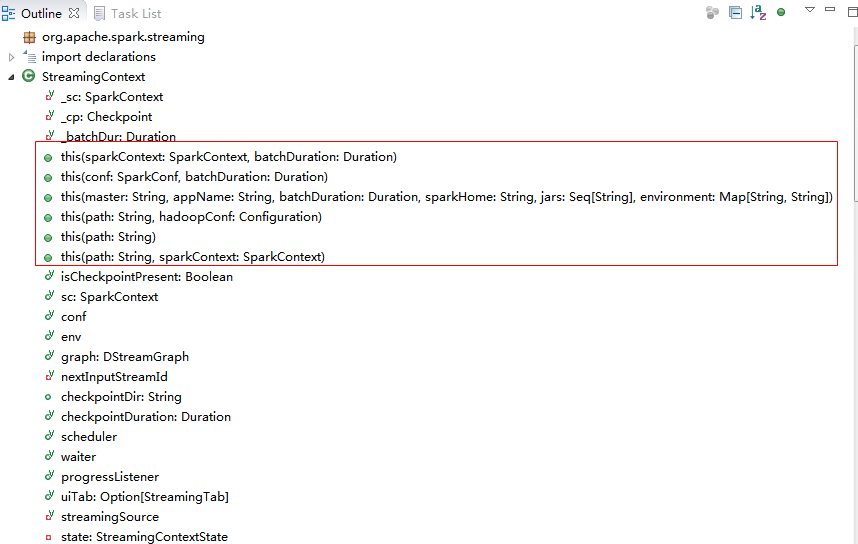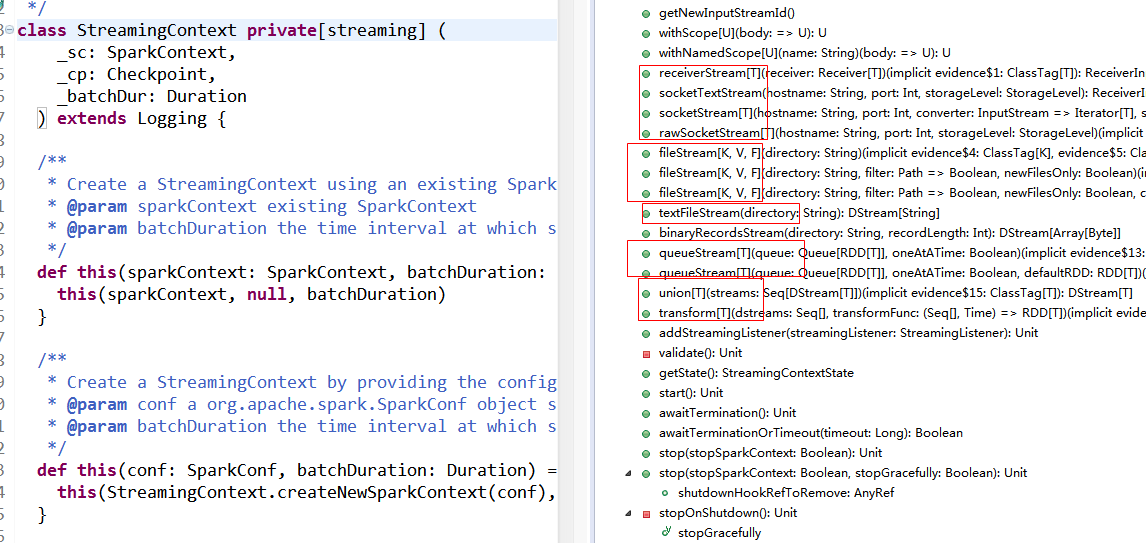Spark Streaming之二:StreamingContext解析
1.1 创建StreamingContext对象

1.1.1通过SparkContext创建
源码如下:
def this(sparkContext: SparkContext, batchDuration: Duration) = {
this(sparkContext, null, batchDuration)
}
第一参数为sparkContext对象,第二个参数为批次时间;
创建实例:
val ssc = new StreamingContext(sc, Seconds(5))
1.1.2通过SparkConf创建
源码如下:
def this(conf: SparkConf, batchDuration: Duration) = {
this(StreamingContext.createNewSparkContext(conf), null, batchDuration)
}
第一参数为SparkConf对象,第二个参数为批次时间;
创建实例:
val conf =new SparkConf().setAppName("StreamTest")
val ssc = new StreamingContext(conf,Seconds(5))
1.1.3通过SparkConf参数创建
源码如下:
def this(
master: String,
appName: String,
batchDuration: Duration,
sparkHome: String = null,
jars: Seq[String] = Nil,
environment: Map[String, String] = Map()) = {
this(StreamingContext.createNewSparkContext(master, appName, sparkHome, jars, environment),
null, batchDuration)
}
第一参数为需要创建SparkConf对象的详细参数,master-spark地址,appName-对象名称,sparkHome- sparkHome环境变量,jars, environment,第二个参数为批次时间;
创建实例:
val ssc = newStreamingContext(“ spark://host:port”, "StreamTest", Seconds(5), System.getenv("SPARK_HOME"),StreamingContext.jarOfClass(this.getClass))
1.1.4通过checkpointfile参数创建
源码如下:
def this(path: String, hadoopConf: Configuration) =
this(null, CheckpointReader.read(path, new SparkConf(), hadoopConf).orNull, null)
第一参数为checkpoint file的路径,第二个参数为haoop的配置
1.2创建Dstream监听对象

1.2.1 fileStream
val ssc = new StreamingContext(sparkConf, Seconds(10))
ssc.fileStream(directory)
源码如下:
/**
* Create an input stream that monitors a Hadoop-compatible filesystem
* for new files and reads them using the given key-value types and input format.
* Files must be written to the monitored directory by "moving" them from another
* location within the same file system. File names starting with . are ignored.
* @param directory HDFS directory to monitor for new file
* @tparam K Key type for reading HDFS file
* @tparam V Value type for reading HDFS file
* @tparam F Input format for reading HDFS file
*/
def fileStream[
K: ClassTag,
V: ClassTag,
F <: NewInputFormat[K, V]: ClassTag
] (directory: String): InputDStream[(K, V)] = {
new FileInputDStream[K, V, F](this, directory)
}
参数:K-读入HDFS的Key的类型,V-读入HDFS的Value的类型,F-读入HDFS的类型;directory-监听HDFS的路径,filter-对监听HDFS的文件进行过滤的函数,newFilesOnly-是否只监听新增文件;
fileStream可以通过设置filter函数,对监听目录下的文件进行过滤,只对满足条件的文件进行监听和处理;
默认过滤方法:
def defaultFilter(path: Path): Boolean = !path.getName().startsWith(".")
该方法是过滤以隐藏文件。
fileStream可以通过设置newFilesOnly为TRUE或者FALES,是否处理监听目录下已存在的文件,默认是不处理已存在文件,只处理新增加文件,如果设置为FALES,可以处理前一个窗口时间内的老文件。
源码如下:在class FileInputDStream里:
private val initialModTimeIgnoreThreshold = if (newFilesOnly) clock.getTimeMillis() else 0L
private def findNewFiles(currentTime: Long): Array[String] = {
try {
lastNewFileFindingTime = clock.getTimeMillis()
// Calculate ignore threshold
val modTimeIgnoreThreshold = math.max(
initialModTimeIgnoreThreshold, // initial threshold based on newFilesOnly setting
currentTime - durationToRemember.milliseconds // trailing end of the remember window
)
...
modTimeIgnoreThreshold是时间窗口过滤条件,通过newFilesOnly值来取的是当前时间或者前一个窗口时间。
创建实例:
// 创建新过滤函数
def myFilter(path:Path): Boolean = path.getName().contains("data")
// 创建fileStream
val data1 = ssc.fileStream[LongWritable,Text, TextInputFormat](Spath1, pa => myFilter(pa),false).map(_._2.toString)
1.2.2 textFileStream
val ssc = new StreamingContext(sparkConf, Seconds(10))
ssc.textFileStream(directory)
源码如下:
/**
* Create an input stream that monitors a Hadoop-compatible filesystem
* for new files and reads them as text files (using key as LongWritable, value
* as Text and input format as TextInputFormat). Files must be written to the
* monitored directory by "moving" them from another location within the same
* file system. File names starting with . are ignored.
* @param directory HDFS directory to monitor for new file
*/
def textFileStream(directory: String): DStream[String] = withNamedScope("text file stream") {
fileStream[LongWritable, Text, TextInputFormat](directory).map(_._2.toString)
}
参数:directory监听的目录;
其实textFileStream是fileStream的一个实例。
创建实例:
val StreamFile1=ssc.textFileStream(Spath1)
1.2.3 socketTextStream
val ssc = new StreamingContext(sparkConf, Seconds(10))
ssc.socketStream(hostname, port, converter, storageLevel)
源码如下:
/**
* Creates an input stream from TCP source hostname:port. Data is received using
* a TCP socket and the receive bytes it interpreted as object using the given
* converter.
* @param hostname Hostname to connect to for receiving data
* @param port Port to connect to for receiving data
* @param converter Function to convert the byte stream to objects
* @param storageLevel Storage level to use for storing the received objects
* @tparam T Type of the objects received (after converting bytes to objects)
*/
def socketStream[T: ClassTag](
hostname: String,
port: Int,
converter: (InputStream) => Iterator[T],
storageLevel: StorageLevel
): ReceiverInputDStream[T] = {
new SocketInputDStream[T](this, hostname, port, converter, storageLevel)
}
参数:hostname是主机IP,port是端口号,storageLevel数据的存储级别,默认2份MEMORY_AND_DISK;
创建实例:
val lines = ssc.socketTextStream(serverIP, serverPort);
1.2.4 rawSocketStream
val ssc = new StreamingContext(sparkConf, Seconds(10))
ssc.rawSocketStream(hostname, port, storageLevel)
源码如下:
/**
* Create an input stream from network source hostname:port, where data is received
* as serialized blocks (serialized using the Spark's serializer) that can be directly
* pushed into the block manager without deserializing them. This is the most efficient
* way to receive data.
* @param hostname Hostname to connect to for receiving data
* @param port Port to connect to for receiving data
* @param storageLevel Storage level to use for storing the received objects
* (default: StorageLevel.MEMORY_AND_DISK_SER_2)
* @tparam T Type of the objects in the received blocks
*/
def rawSocketStream[T: ClassTag](
hostname: String,
port: Int,
storageLevel: StorageLevel = StorageLevel.MEMORY_AND_DISK_SER_2
): ReceiverInputDStream[T] = withNamedScope("raw socket stream") {
new RawInputDStream[T](this, hostname, port, storageLevel)
}
rawSocketStream类似于socketTextStream;参照socketTextStream。
1.2.5 networkStream
源码如下:
/**
* Create an input stream with any arbitrary user implemented receiver.
* Find more details at:http://spark.apache.org/docs/latest/streaming-custom-receivers.html
* @param receiver Custom implementation of Receiver
*/
@deprecated("Use receiverStream","1.0.0")
def networkStream[T: ClassTag](
receiver: Receiver[T]): ReceiverInputDStream[T] = {
receiverStream(receiver)
}
创建实例:
参照:http://spark.apache.org/docs/latest/streaming-custom-receivers.html
1.2.6 receiverStream
val ssc = new StreamingContext(sparkConf, Seconds(10))
ssc.receiverStream(receiver)
源码如下:
/**
* Create an input stream with any arbitrary user implemented receiver.
* Find more details at http://spark.apache.org/docs/latest/streaming-custom-receivers.html
* @param receiver Custom implementation of Receiver
*/
def receiverStream[T: ClassTag](receiver: Receiver[T]): ReceiverInputDStream[T] = {
withNamedScope("receiver stream") {
new PluggableInputDStream[T](this, receiver)
}
}
参照:http://spark.apache.org/docs/latest/streaming-custom-receivers.html
1.2.7 actorStream
源码如下:
/**
* Create an input stream with any arbitrary user implemented actorreceiver.
* Find more details at:http://spark.apache.org/docs/latest/streaming-custom-receivers.html
* @param props Props object defining creation of the actor
* @param name Name of the actor
* @param storageLevel RDD storage level (default:StorageLevel.MEMORY_AND_DISK_SER_2)
*
* @note An important point to note:
* Since Actor may exist outsidethe spark framework, It is thus user's responsibility
* to ensure the type safety,i.e parametrized type of data received and actorStream
* should be same.
*/
defactorStream[T: ClassTag](
props: Props,
name: String,
storageLevel: StorageLevel = StorageLevel.MEMORY_AND_DISK_SER_2,
supervisorStrategy: SupervisorStrategy =ActorSupervisorStrategy.defaultStrategy
): ReceiverInputDStream[T] = {
receiverStream(new ActorReceiver[T](props, name, storageLevel, supervisorStrategy))
}
创建实例:
val StreamFile1 = ssc.actorStream[String](Props(newCustomActor()),"CustomReceiver")
参照:http://spark.apache.org/docs/latest/streaming-custom-receivers.html
1.2.8 queueStream
val ssc = new StreamingContext(sparkConf, Seconds(10))
ssc.queueStream(queue, oneAtATime)
源码如下:
/**
* Create an input stream from a queue of RDDs. In each batch,
* it will process either one or all of the RDDs returned by the queue.
*
* NOTE: Arbitrary RDDs can be added to `queueStream`, there is no way to recover data of
* those RDDs, so `queueStream` doesn't support checkpointing.
*
* @param queue Queue of RDDs. Modifications to this data structure must be synchronized.
* @param oneAtATime Whether only one RDD should be consumed from the queue in every interval
* @tparam T Type of objects in the RDD
*/
def queueStream[T: ClassTag](
queue: Queue[RDD[T]],
oneAtATime: Boolean = true
): InputDStream[T] = {
queueStream(queue, oneAtATime, sc.makeRDD(Seq[T](), 1))
}
1.2.9 union DStream
val ssc = new StreamingContext(sparkConf, Seconds(10))
ssc.union(streams)
源码如下:
/**
* Create a unified DStream from multiple DStreams of the same type and same slide duration.
*/
def union[T: ClassTag](streams: Seq[DStream[T]]): DStream[T] = withScope {
new UnionDStream[T](streams.toArray)
}
对同一类型的DStream进行合并,生成一个新的DStream,其中要求DStream的数据格式一致,批次时间间隔一致。
1.2.10 transform DStream
val ssc = new StreamingContext(sparkConf, Seconds(10))
ssc.transform(dstreams, transformFunc)
源码如下:
/**
* Create a new DStream in which each RDD is generated by applying a function on RDDs of
* the DStreams.
*/
def transform[T: ClassTag](
dstreams: Seq[DStream[_]],
transformFunc: (Seq[RDD[_]], Time) => RDD[T]
): DStream[T] = withScope {
new TransformedDStream[T](dstreams, sparkContext.clean(transformFunc))
}
对Dstream进行transform操作生成一个新的Dstream。
1.3 Checkpointing
状态的操作是基于多个批次的数据的。它包括基于window的操作和updateStateByKey。因为状态的操作要依赖于上一个批次的数据,所以它要根据时间,不断累积元数据。为了清空数据,它支持周期性的检查点,通过把中间结果保存到hdfs上。因为检查操作会导致保存到hdfs上的开销,所以设置这个时间间隔,要很慎重。对于小批次的数据,比如一秒的,检查操作会大大降低吞吐量。但是检查的间隔太长,会导致任务变大。通常来说,5-10秒的检查间隔时间是比较合适的。
实例:
ssc.checkpoint("hdfs://192.168.1.100:9000/check")
val StreamFile1=ssc.textFileStream(Spath1)
StreamFile1.checkpoint(Seconds(30))
转载请注明出处:
http://blog.csdn.net/sunbow0/article/details/42966467
Spark Streaming之二:StreamingContext解析的更多相关文章
- Spark Streaming揭秘 Day25 StreamingContext和JobScheduler启动源码详解
Spark Streaming揭秘 Day25 StreamingContext和JobScheduler启动源码详解 今天主要理一下StreamingContext的启动过程,其中最为重要的就是Jo ...
- Spark Streaming之三:DStream解析
DStream 1.1基本说明 1.1.1 Duration Spark Streaming的时间类型,单位是毫秒: 生成方式如下: 1)new Duration(milli seconds) 输入毫 ...
- spark streaming 使用geoIP解析IP
1.首先将GEOIP放到服务器上,如,/opt/db/geo/GeoLite2-City.mmdb 2.新建scala sbt工程,测试是否可以顺利解析 import java.io.Fileimpo ...
- Spark Streaming源码解读之数据清理内幕彻底解密
本期内容 : Spark Streaming数据清理原理和现象 Spark Streaming数据清理代码解析 Spark Streaming一直在运行的,在计算的过程中会不断的产生RDD ,如每秒钟 ...
- 通过案例对 spark streaming 透彻理解三板斧之一: spark streaming 另类实验
本期内容 : spark streaming另类在线实验 瞬间理解spark streaming本质 一. 我们最开始将从Spark Streaming入手 为何从Spark Streaming切入 ...
- Spark Streaming no receivers彻底思考
数据接入Spark Streaming的二种方式:Receiver和no receivers方式 建议企业级采用no receivers方式开发Spark Streaming应用程序,好处: 1.更优 ...
- spark系列-8、Spark Streaming
参考链接:http://spark.apache.org/docs/latest/streaming-programming-guide.html 一.Spark Streaming 介绍 Spark ...
- Spark入门实战系列--7.Spark Streaming(上)--实时流计算Spark Streaming原理介绍
[注]该系列文章以及使用到安装包/测试数据 可以在<倾情大奉送--Spark入门实战系列>获取 .Spark Streaming简介 1.1 概述 Spark Streaming 是Spa ...
- Spark入门实战系列--7.Spark Streaming(下)--实时流计算Spark Streaming实战
[注]该系列文章以及使用到安装包/测试数据 可以在<倾情大奉送--Spark入门实战系列>获取 .实例演示 1.1 流数据模拟器 1.1.1 流数据说明 在实例演示中模拟实际情况,需要源源 ...
随机推荐
- Go语言阅读小笔记,来自知呼达达关于unsafe.Pointer的分享.
第一式 - 获得Slice和String的内存数据 func stringPointer(s string) unsafe.Pointer { p := (*reflect.StringHeader) ...
- C 标准库 - <setjmp.h>
C 标准库 - <setjmp.h> 简介 setjmp.h 头文件定义了宏 setjmp().函数 longjmp() 和变量类型 jmp_buf,该变量类型会绕过正常的函数调用和返回规 ...
- hibernate session缓存
Session 概述 Session 接口是 Hibernate 向应用程序提供的操纵数据库的最基本的接口, 它提供了基本的保存, 更新, 删除和载入 Java 对象的方法. Session 具有一个 ...
- 关于Adapter对数据库的查询、删除操作
watermark/2/text/aHR0cDovL2Jsb2cuY3Nkbi5uZXQvdTAxMzIxMDYyMA==/font/5a6L5L2T/fontsize/400/fill/I0JBQk ...
- hibernate5(10)注解映射[2]一对多单向关联
在上一篇文章里.我们从端方向一端建立关联关系,完毕了从文章到作者的关联关系建立.但在实际的博客站点中,用户肯定还须要获取自己所写的文章,这时能够建立用户(一)对文章(多)的单向关联映射. 先来看我们的 ...
- 2016年最值得新手程序猿阅读的书:《增长project师指南》
这本书的来源于根据我在<Repractise简单介绍篇:Web开发的七天里>中所说的 Web 开发的七个步骤而展开的电子书.当然它也是一个 APP.它一本关于怎样成为增长project师的 ...
- Html.DropDownListFor的选项值为字符型问题
我快要疯了.asp.net mvc的这个DropDownListFor,无论在服务器端如何设置,设置哪个值被选中,结果到了页面输出,选中值根本没有被选中,没有任何一个值被选中,下拉框只冷冰冰地显示一个 ...
- 【BZOJ3041】水叮当的舞步 迭代深搜IDA*
[BZOJ3041]水叮当的舞步 Description 水叮当得到了一块五颜六色的格子形地毯作为生日礼物,更加特别的是,地毯上格子的颜色还能随着踩踏而改变.为了讨好她的偶像虹猫,水叮当决定在地毯上跳 ...
- 用live555将内网摄像机视频推送到外网服务器,附源码
最近很多人问,如何将内网的摄像机流媒体数据发布到公网,如果用公网与局域网间的端口映射方式太过麻烦,一个摄像机要做一组映射,而且不是每一个局域网都是有固定ip地址,即使外网主机配置好了每一个摄像机的映射 ...
- 使用JavaScript获取浏览器UserAgent
可以在浏览器地址栏输入about:version来查看UserAgent等信息 但是在Win10系统,本人亲测,IE和Edge用这样的方式都获取不到信息 在我惯用的QQ浏览器上倒是可以获取到 为了能方 ...
